Yanchao Yang
Learning Human-Humanoid Coordination for Collaborative Object Carrying
Oct 16, 2025Abstract:Human-humanoid collaboration shows significant promise for applications in healthcare, domestic assistance, and manufacturing. While compliant robot-human collaboration has been extensively developed for robotic arms, enabling compliant human-humanoid collaboration remains largely unexplored due to humanoids' complex whole-body dynamics. In this paper, we propose a proprioception-only reinforcement learning approach, COLA, that combines leader and follower behaviors within a single policy. The model is trained in a closed-loop environment with dynamic object interactions to predict object motion patterns and human intentions implicitly, enabling compliant collaboration to maintain load balance through coordinated trajectory planning. We evaluate our approach through comprehensive simulator and real-world experiments on collaborative carrying tasks, demonstrating the effectiveness, generalization, and robustness of our model across various terrains and objects. Simulation experiments demonstrate that our model reduces human effort by 24.7%. compared to baseline approaches while maintaining object stability. Real-world experiments validate robust collaborative carrying across different object types (boxes, desks, stretchers, etc.) and movement patterns (straight-line, turning, slope climbing). Human user studies with 23 participants confirm an average improvement of 27.4% compared to baseline models. Our method enables compliant human-humanoid collaborative carrying without requiring external sensors or complex interaction models, offering a practical solution for real-world deployment.
HyperTASR: Hypernetwork-Driven Task-Aware Scene Representations for Robust Manipulation
Aug 26, 2025Abstract:Effective policy learning for robotic manipulation requires scene representations that selectively capture task-relevant environmental features. Current approaches typically employ task-agnostic representation extraction, failing to emulate the dynamic perceptual adaptation observed in human cognition. We present HyperTASR, a hypernetwork-driven framework that modulates scene representations based on both task objectives and the execution phase. Our architecture dynamically generates representation transformation parameters conditioned on task specifications and progression state, enabling representations to evolve contextually throughout task execution. This approach maintains architectural compatibility with existing policy learning frameworks while fundamentally reconfiguring how visual features are processed. Unlike methods that simply concatenate or fuse task embeddings with task-agnostic representations, HyperTASR establishes computational separation between task-contextual and state-dependent processing paths, enhancing learning efficiency and representational quality. Comprehensive evaluations in both simulation and real-world environments demonstrate substantial performance improvements across different representation paradigms. Through ablation studies and attention visualization, we confirm that our approach selectively prioritizes task-relevant scene information, closely mirroring human adaptive perception during manipulation tasks. The project website is at \href{https://lisunphil.github.io/HyperTASR_projectpage/}{lisunphil.github.io/HyperTASR\_projectpage}.
HuMoCon: Concept Discovery for Human Motion Understanding
May 27, 2025
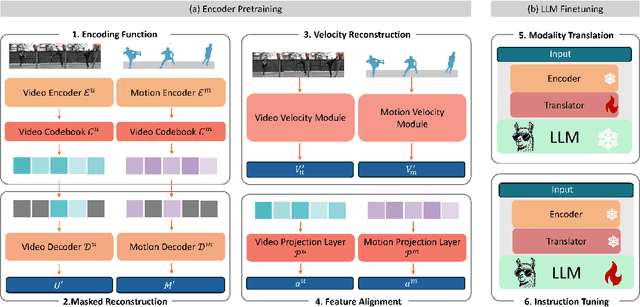
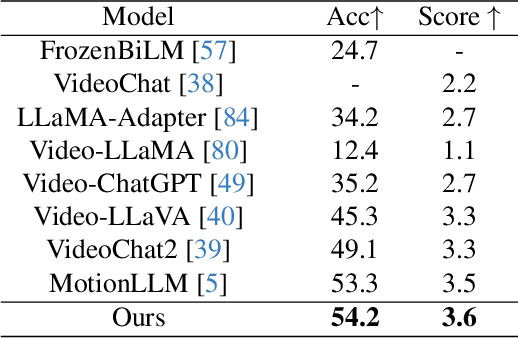

Abstract:We present HuMoCon, a novel motion-video understanding framework designed for advanced human behavior analysis. The core of our method is a human motion concept discovery framework that efficiently trains multi-modal encoders to extract semantically meaningful and generalizable features. HuMoCon addresses key challenges in motion concept discovery for understanding and reasoning, including the lack of explicit multi-modality feature alignment and the loss of high-frequency information in masked autoencoding frameworks. Our approach integrates a feature alignment strategy that leverages video for contextual understanding and motion for fine-grained interaction modeling, further with a velocity reconstruction mechanism to enhance high-frequency feature expression and mitigate temporal over-smoothing. Comprehensive experiments on standard benchmarks demonstrate that HuMoCon enables effective motion concept discovery and significantly outperforms state-of-the-art methods in training large models for human motion understanding. We will open-source the associated code with our paper.
* 18 pages, 10 figures
SLAM3R: Real-Time Dense Scene Reconstruction from Monocular RGB Videos
Dec 12, 2024Abstract:In this paper, we introduce \textbf{SLAM3R}, a novel and effective monocular RGB SLAM system for real-time and high-quality dense 3D reconstruction. SLAM3R provides an end-to-end solution by seamlessly integrating local 3D reconstruction and global coordinate registration through feed-forward neural networks. Given an input video, the system first converts it into overlapping clips using a sliding window mechanism. Unlike traditional pose optimization-based methods, SLAM3R directly regresses 3D pointmaps from RGB images in each window and progressively aligns and deforms these local pointmaps to create a globally consistent scene reconstruction - all without explicitly solving any camera parameters. Experiments across datasets consistently show that SLAM3R achieves state-of-the-art reconstruction accuracy and completeness while maintaining real-time performance at 20+ FPS. Code and weights at: \url{https://github.com/PKU-VCL-3DV/SLAM3R}.
Reloc3r: Large-Scale Training of Relative Camera Pose Regression for Generalizable, Fast, and Accurate Visual Localization
Dec 11, 2024Abstract:Visual localization aims to determine the camera pose of a query image relative to a database of posed images. In recent years, deep neural networks that directly regress camera poses have gained popularity due to their fast inference capabilities. However, existing methods struggle to either generalize well to new scenes or provide accurate camera pose estimates. To address these issues, we present \textbf{Reloc3r}, a simple yet effective visual localization framework. It consists of an elegantly designed relative pose regression network, and a minimalist motion averaging module for absolute pose estimation. Trained on approximately 8 million posed image pairs, Reloc3r achieves surprisingly good performance and generalization ability. We conduct extensive experiments on 6 public datasets, consistently demonstrating the effectiveness and efficiency of the proposed method. It provides high-quality camera pose estimates in real time and generalizes to novel scenes. Code, weights, and data at: \url{https://github.com/ffrivera0/reloc3r}.
CigTime: Corrective Instruction Generation Through Inverse Motion Editing
Dec 06, 2024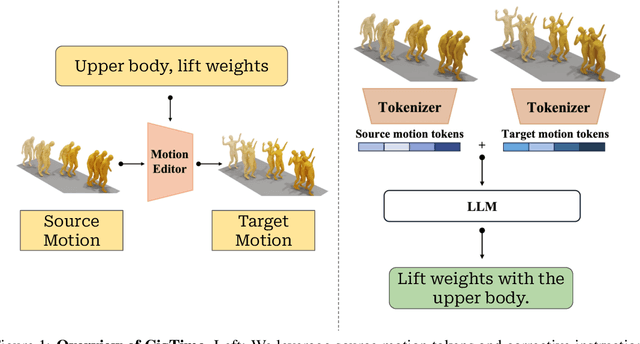

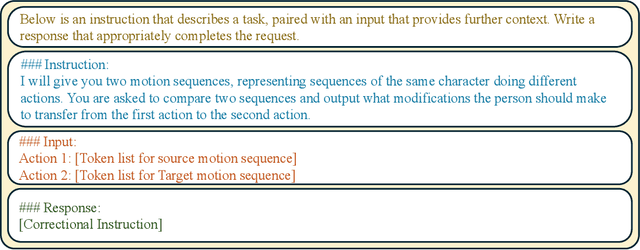

Abstract:Recent advancements in models linking natural language with human motions have shown significant promise in motion generation and editing based on instructional text. Motivated by applications in sports coaching and motor skill learning, we investigate the inverse problem: generating corrective instructional text, leveraging motion editing and generation models. We introduce a novel approach that, given a user's current motion (source) and the desired motion (target), generates text instructions to guide the user towards achieving the target motion. We leverage large language models to generate corrective texts and utilize existing motion generation and editing frameworks to compile datasets of triplets (source motion, target motion, and corrective text). Using this data, we propose a new motion-language model for generating corrective instructions. We present both qualitative and quantitative results across a diverse range of applications that largely improve upon baselines. Our approach demonstrates its effectiveness in instructional scenarios, offering text-based guidance to correct and enhance user performance.
On the Evaluation of Generative Robotic Simulations
Oct 10, 2024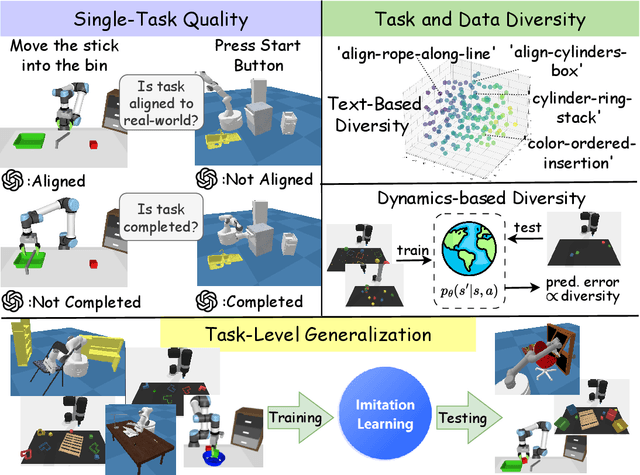
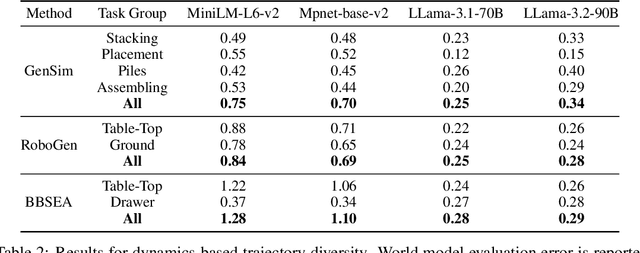
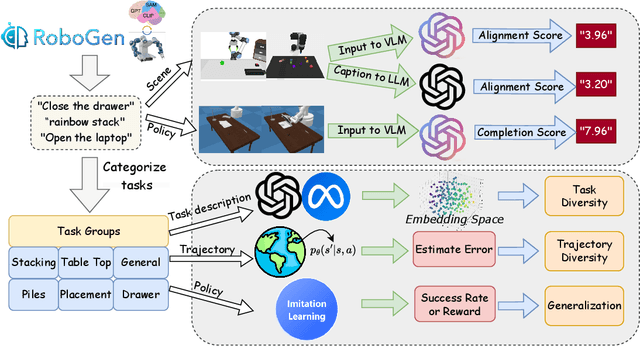

Abstract:Due to the difficulty of acquiring extensive real-world data, robot simulation has become crucial for parallel training and sim-to-real transfer, highlighting the importance of scalable simulated robotic tasks. Foundation models have demonstrated impressive capacities in autonomously generating feasible robotic tasks. However, this new paradigm underscores the challenge of adequately evaluating these autonomously generated tasks. To address this, we propose a comprehensive evaluation framework tailored to generative simulations. Our framework segments evaluation into three core aspects: quality, diversity, and generalization. For single-task quality, we evaluate the realism of the generated task and the completeness of the generated trajectories using large language models and vision-language models. In terms of diversity, we measure both task and data diversity through text similarity of task descriptions and world model loss trained on collected task trajectories. For task-level generalization, we assess the zero-shot generalization ability on unseen tasks of a policy trained with multiple generated tasks. Experiments conducted on three representative task generation pipelines demonstrate that the results from our framework are highly consistent with human evaluations, confirming the feasibility and validity of our approach. The findings reveal that while metrics of quality and diversity can be achieved through certain methods, no single approach excels across all metrics, suggesting a need for greater focus on balancing these different metrics. Additionally, our analysis further highlights the common challenge of low generalization capability faced by current works. Our anonymous website: https://sites.google.com/view/evaltasks.
Closed-Loop Visuomotor Control with Generative Expectation for Robotic Manipulation
Sep 13, 2024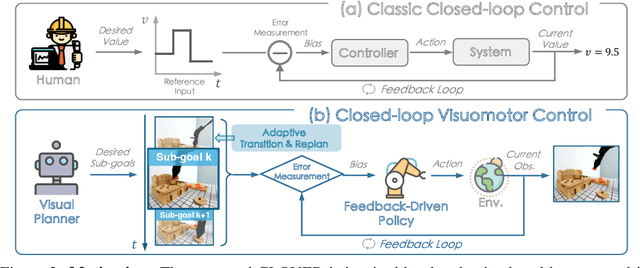



Abstract:Despite significant progress in robotics and embodied AI in recent years, deploying robots for long-horizon tasks remains a great challenge. Majority of prior arts adhere to an open-loop philosophy and lack real-time feedback, leading to error accumulation and undesirable robustness. A handful of approaches have endeavored to establish feedback mechanisms leveraging pixel-level differences or pre-trained visual representations, yet their efficacy and adaptability have been found to be constrained. Inspired by classic closed-loop control systems, we propose CLOVER, a closed-loop visuomotor control framework that incorporates feedback mechanisms to improve adaptive robotic control. CLOVER consists of a text-conditioned video diffusion model for generating visual plans as reference inputs, a measurable embedding space for accurate error quantification, and a feedback-driven controller that refines actions from feedback and initiates replans as needed. Our framework exhibits notable advancement in real-world robotic tasks and achieves state-of-the-art on CALVIN benchmark, improving by 8% over previous open-loop counterparts. Code and checkpoints are maintained at https://github.com/OpenDriveLab/CLOVER.
MaxMI: A Maximal Mutual Information Criterion for Manipulation Concept Discovery
Jul 21, 2024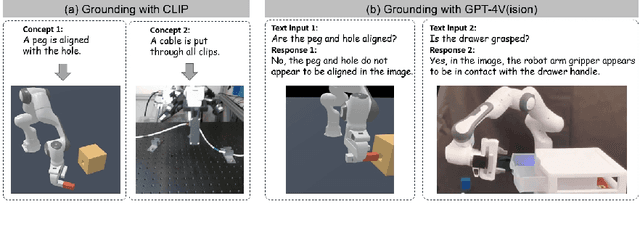
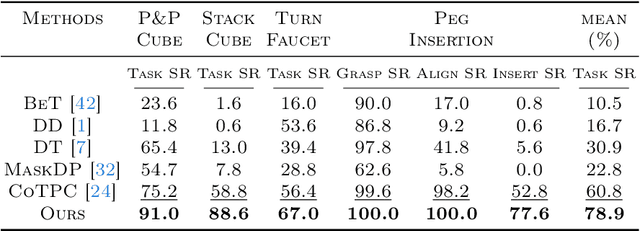
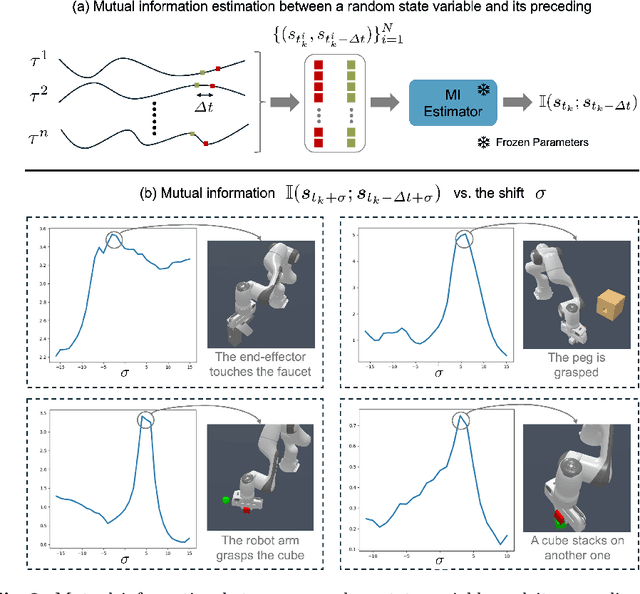

Abstract:We aim to discover manipulation concepts embedded in the unannotated demonstrations, which are recognized as key physical states. The discovered concepts can facilitate training manipulation policies and promote generalization. Current methods relying on multimodal foundation models for deriving key states usually lack accuracy and semantic consistency due to limited multimodal robot data. In contrast, we introduce an information-theoretic criterion to characterize the regularities that signify a set of physical states. We also develop a framework that trains a concept discovery network using this criterion, thus bypassing the dependence on human semantics and alleviating costly human labeling. The proposed criterion is based on the observation that key states, which deserve to be conceptualized, often admit more physical constraints than non-key states. This phenomenon can be formalized as maximizing the mutual information between the putative key state and its preceding state, i.e., Maximal Mutual Information (MaxMI). By employing MaxMI, the trained key state localization network can accurately identify states of sufficient physical significance, exhibiting reasonable semantic compatibility with human perception. Furthermore, the proposed framework produces key states that lead to concept-guided manipulation policies with higher success rates and better generalization in various robotic tasks compared to the baselines, verifying the effectiveness of the proposed criterion.
DISCO: Embodied Navigation and Interaction via Differentiable Scene Semantics and Dual-level Control
Jul 20, 2024



Abstract:Building a general-purpose intelligent home-assistant agent skilled in diverse tasks by human commands is a long-term blueprint of embodied AI research, which poses requirements on task planning, environment modeling, and object interaction. In this work, we study primitive mobile manipulations for embodied agents, i.e. how to navigate and interact based on an instructed verb-noun pair. We propose DISCO, which features non-trivial advancements in contextualized scene modeling and efficient controls. In particular, DISCO incorporates differentiable scene representations of rich semantics in object and affordance, which is dynamically learned on the fly and facilitates navigation planning. Besides, we propose dual-level coarse-to-fine action controls leveraging both global and local cues to accomplish mobile manipulation tasks efficiently. DISCO easily integrates into embodied tasks such as embodied instruction following. To validate our approach, we take the ALFRED benchmark of large-scale long-horizon vision-language navigation and interaction tasks as a test bed. In extensive experiments, we make comprehensive evaluations and demonstrate that DISCO outperforms the art by a sizable +8.6% success rate margin in unseen scenes, even without step-by-step instructions. Our code is publicly released at https://github.com/AllenXuuu/DISCO.
 Add to Chrome
Add to Chrome Add to Firefox
Add to Firefox Add to Edge
Add to Edge